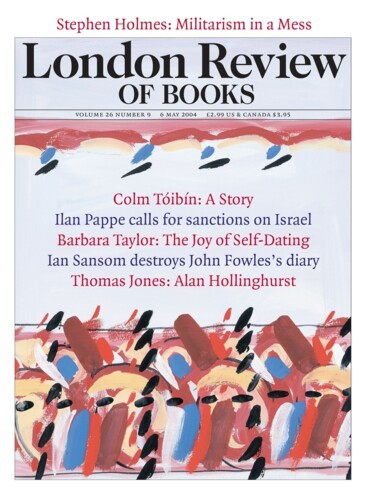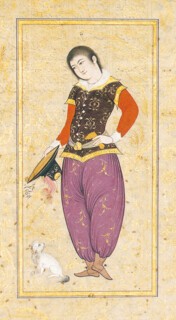The show of Islamic art in the Hermitage Rooms at Somerset House, Heaven on Earth, confirms the general impression you get from royal collections that princes, like children, are drawn to bright, pretty things. Fabergé eggs, extensive stables and private menageries seem to be what really take their fancy, even more than pictures and trophies of arms. The pieces in gold, studded with emeralds and rubies – much of what is here is palace art – perfectly fit the descriptions of magical treasure in fairy-tales.
Almost the first thing you see is not rich in this way at all, however. It is a piece of blue silk, about a metre and a half square, with an overall pattern made up of row on identical row of the name of Allah spelled out in small, neat script. It was, you learn, a mantra, a visible whispering of the name of God.
In this first room, text, in the form of manuscript pages, tiles and embroidery, makes speech visible and gives words from the Koran an enhanced presence. In Europe, the Gothic script of some manuscripts and of early printing (Gutenberg’s, for example) enjoys a similar life as pattern alone. Although we must take care when making judgments about the look of texts we can’t read, there are pages here from two North African Korans of the eighth and 11th centuries in the geometric Kufic script which combine tremendous calligraphic energy with such perfect manual control that one is almost grateful for the ignorance that hides the meaning of the words and increases the impact of the visual residue. Later, when the texts become embedded in yet more elaborate frames of arabesques and flowers, one can wonder at the calligrapher’s patience and skill, but find the richness overpowering.
The vigour of the early, and many of the later inscriptions, could be taken as the response of gifted artists to the prohibition of images, although that prohibition was neither absolute nor universal. J.M. Rogers’s catalogue essay on imperial and religious art is informative, even amusing, about this and much else. ‘Islam seems to be unique,’ he writes, ‘in giving the lawyers and theologians most of the say in judging figural art not as well or badly done, but as right or wrong.’* The earliest cultures in Islam developed the most extreme positions. There is no explicit prohibition of images in the Koran but by the ninth century a collection of Muslim traditions, the Sahih, included condemnations of all painting.
The idea that to represent God is idolatrous and to create illusions of his creation a blasphemous usurping of his powers is, like the various phases of Christian iconoclasm, an instance of the desire to separate the real from the illusion and contains a strong aesthetic component. The fear that figuration distracts people from the true nature of things is not irrational.
But whatever the status of representation in the Islamic traditions, pattern-making rules. Islamic art’s elegance results from a reordering and rearrangement of observed fact: plants are painted with a botanist’s interest in detail, arranged (but with infinitely more grace) as they would be on a herbarium sheet; figures become exercises in calligraphy which must, in part, be translated as one translates an axonometric architectural drawing. Subject-matter which became obscured in European painting as the forms of illusionism advanced, and parts faded into shadow or were suggested but not shown, is here complete: the pattern of a fabric or a tiled floor, say, in perfect perspectiveless detail. When European conventions intrude, as they did in the 16th century in Mughal India, or the 19th in Persian miniature painting, the inexcusable coy complaint ‘why can’t they stick to the old ways?’ comes to one’s lips. Take the 1881 portrait of Nasir al-Din Shah in which the floor tiles are in perspective and he sits on a European stool in frock-coat and spats. The flow of lines in the miniature of 1648 shown here by Mu’in Musawwir, of a European youth in Portuguese dress, which makes the folds of cloth seem as natural and coherent as the petals of a flower, is now a distant memory. The catalogue notes that ‘in contrast to those earlier Persian rulers, who practised painting, calligraphy or poetry, Nasir al-Din Shah was an enthusiastic amateur photographer’: only uncertainty about anatomy separates the Shah’s portrait from a photographer’s posed image.
Animals are both an example and a subject for pattern-making cultures. Their fur, feathers and skins, wonderfully textured and coloured, the symmetry of the patterns they make and the exquisite arrays of stripes and spots are there to be emulated. In the exhibition they can be found in almost every item which has any figurative elements. The prince shown in a bold, caricature-like drawing on an earthenware bowl from eastern Iran of around 1000 holds a bird and is flanked by a dachshund biting a leaf (that is the catalogue’s identification – Crufts might object) and a small feline. There are ewers like eagles and cockerels, incense-burners like lynxes and a water-pourer in the form of an unfortunate humped cow (properly a zebu) which suckles its calf while a lion bites its hump. Violence is not unusual; animals chase and bite one another in the margins of some of the prettiest album pages; in an illustration from the ‘Houghton’ Shahname, exquisitely dressed riders strike and shoot at goats and cattle, which meet their death on a delicate flowery meadow. (This sheet can be seen only in the catalogue at the moment; a new group of pictures, of which it is one, will replace the present selection in June.) The Arabian Nights, one remembers, is full of severed heads and impaled enemies as well as descriptions of flowering gardens, feasts, fine clothes and beautiful boys and girls.
This is not a large exhibition, but it covers a daunting range in time and territory. Experts will be able to explain how the pieces here, drawn from the Hermitage Museum and the Khalili Collection, stand in relation to others, but to take pleasure in them requires only a taste for abstract geometry, strong colour and prettiness.
Send Letters To:
The Editor
London Review of Books,
28 Little Russell Street
London, WC1A 2HN
letters@lrb.co.uk
Please include name, address, and a telephone number.


